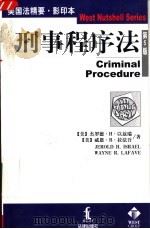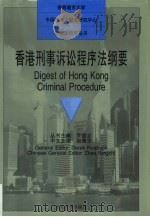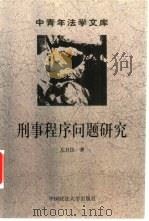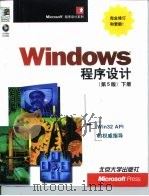《刑事程序法 第5版 英文》
| 作者 | (美)杰罗德·H·以兹瑞,威恩·R·拉法吾著 编者 |
|---|---|
| 出版 | 北京:法律出版社 |
| 参考页数 | 488 |
| 出版时间 | 1999(求助前请核对) 目录预览 |
| ISBN号 | 7503628715 — 求助条款 |
| PDF编号 | 88797318(仅供预览,未存储实际文件) |
| 求助格式 | 扫描PDF(若分多册发行,每次仅能受理1册) |

PREFACE1
Chapter 1.The Constitutionalization of Criminal Procedure1
1.1 Introduction1
(a) The"criminal justice revolution"1
(b) The Constitution and criminal procedure3
(c) Constitutionalization4
(a) Introduction10
1.2 Application of Bill of Rights Guarantees to the States10
(b) The fundamental rights interpretation11
(c) The total incorporation interpretation14
(d) The shift to selective incorporation16
TABLE OF CASES21
(e)Subsequent developments21
1.3 Exqansive Interpretations of Individual Guarantees25
(a) Judicial protection of civil liberties26
(b) The priority of reliability guarantees29
1.3 Expansive Interpretations of Individual Guarantees—Continued32
(c) Historical acceptance32
(d) The desirability of a per se analysis36
(e) The desirability of prophylactic requirements40
(f) Administrative burdens42
(a) The Linkletter approach44
1.4 The Doctrine of Limited Retroactive Application44
(b) Restricting Linkletter:Full retroactivity prior to conviction finality50
(c) Rejecting Linkletter:The Teague standards for finalized convictions52
Chapter 2.Arrest,Search and Seizure57
2.1 Introduction57
(a) The Fourth Amendment57
(b) Seizure of the person58
(c) The major issues59
(a) Property interests vs. privacy interests60
2.2 Protected Areas and Interests60
(b) Plain view,smell and hearing62
(c) Residential premises64
(d) Other premises and places65
(e) Vehicles67
(f) Effects67
2.2 Protected Areas and Interests—Continued70
(g) Surveillance of relationships and movements70
2.3 "Probable Cause"and Related Problems71
(a) When and why"probable cause"in issue71
(b) Degree of probability75
(c) Information which may be considered77
(d) Information from informants77
(e) Information from other sources82
(f) Unconstitutional statute83
2.4 Search Warrants:Issuance83
(a) Who may issue83
(b) Passage of time since facts gathered84
(c) Particular description of place or person to be searched86
(d) Particular description of things to be seized87
(a) Time of execution89
2.5 Search Warrants:Execution89
(b) Entry without notice90
(c) Detention and search of persons on the premises to be searched91
(d) Seizure of items not named in the warrant92
2.6 Warrantless Searches and Seizures of Persons93
(a) Arrest93
(b) Search incident to arrest96
(c) Time of search;inventory98
(d) "Subterfuge"arrests100
(e) The significance of booking101
(a) Entry to arrest102
2.7 Warrantless Searches and Seizures of Premises102
(b) Entry without notice105
(c) Search incident to and after arrest106
(d) Plain view109
(e) Search to prevent loss of evidence109
2.8 Warrantless Searches and Seizures of Automobiles112
(a) Search incident to arrest112
(b) Search on probable cause113
(c) Search of containers and persons therein115
(d) Inventory116
(a) Background118
2.9 Stop-and-Frisk and Other Brief Detention118
(b) Temporary seizure for investigation120
(c) No seizure and arrest distinguished124
(d) Protective search126
(e) Brief detention at the station128
2.10 Grand Jury Subpoenas129
2.11 Inspections;Regulatory Searches131
(a) Inspection of premises131
(b) Border searches133
(d) Airport inspections135
(c) Driver's license,vehicle registration and DWI checks135
(e) Supervision of prisoners,probationers and parolees136
(f) Supervision of students137
(g) Supervision of employees137
2.12 Consent Searches138
(a) Background138
(b) Warning of rights139
(c) Consent subsequent to a claim of authority140
(d) Other relevant factors141
(e) Scope of consent142
(f) Consent by deception143
2.13 Third Party Consent144
(a) Background144
(b) Relationship of third party to defendant and place searched145
(c) Apparent authority148
(d) Exclusive control149
Chapter 3.Wiretapping,Electronic Eavesdropping,and the Use of Secret Agents150
3.1 Historical Background;Application of Fourth Amendment150
(a) The Olmstead case150
(b) Section 605151
3.1 Historical Background;Application of Fourth Amendment—Continued151
(c) Non-telephonic electronic eavesdropping152
3.2 Constitutionality of Title III of the Crime Control Act153
(a) Background153
(b) Summary of Title III154
(c) Continued surveillance158
(d) Lack of notice161
(e) Other considerations162
3.3 The Use of Secret Agents to Obtain Incriminating Statements165
(a) "Wired"agents:On Lee and Lopez165
(b) Without"bugging":Lewis and Hoffa166
(c) The impact of Katz168
3.4 Disclosure of Electronic Sureillance Records170
(a) The"fruits"of surveillance170
(b) The Alderman disclosure requirement170
(c) The statutory limitation172
3.5 The Use of Secret Agents to"Encourage"Criminal Conduct173
(a) Entrapment173
(b) Possible constitutional bases174
Chapter 4.Police Interrogation and Confessions177
4.1 Introduction177
(a) The confession dilemma177
(b) The Supreme Court's response179
4.2 The"Voluntariness"—"Totality of Circumstances"Test181
(a) Objectives of the test181
(b) The reievant circumstances185
(c) Administration of the test186
4.3 The Right to Counsel187
(a) Pre-Escobedo developments187
(b) The Escobedo case189
(c) The meaning of Escobedo190
(d) The Williams case191
(e) When the right attaches192
(f) Waiver of counsel194
(g) Infringement of the right196
4.4 The Privilege Against Self-Incrimination198
(a) The privilege in the police station198
(b) The Miranda rules200
(c) Criticism of Miranda202
(d) The Crime Control Act203
(b) Tax investigations205
(c) Proceeding at which confession offered205
(a) Traffic and other minor offenses205
4.5 Miranda:What Offenses Are Covered?205
4.6 Miranda:When is Interrogation"Custodial"?206
(a) "Custody"vs."focus"206
(b) Purpose of the custody207
(c) Subjective vs. objective approach207
(d) Presence at station209
(e) Presence elsewhere209
4.7 Miranda What Constitutes"Interrogation"?210
(a) "Volunteered"statements210
(b) Follow-up questioning211
(c) The"functional equivalent"of questioning212
(d) Purpose of the questioning215
(e) Questioning by non-police217
4.8 Miranda What Warnings Are Required?218
(a) Adequacy of the warnings218
(b) "Cutting off"the warnings219
(c) Multiple interrogation sessions220
(d) Additional admonitions220
4.9 Miranda:What Constitutes Waiver?222
(a) Express or implied222
(b) Facts bearing on the waiver222
(c) Waiver after assertion of rights224
(a) Application of the privilege227
4.10 Self-Incrimination and the Grand Jury Witness227
(b) Need for self-incrimination warnings228
4.10 Self-Incrimination and the Grand Jury Witness—Continued230
(c) Subpoenas for documents230
(d) Immunity233
Chapter 5.Lineups and Other Pretrial Identification Procedures236
5.1 The Privilege Against Self-Incrimination236
(a) The Schmerber case236
(b) Application to pretrial identification237
(d) Change in appearance238
(c) Consequences of failure to cooperate238
5.2 The Right to Counsel and Confrontation:Lineups239
(a) Procedures required239
(b) Waiver of counsel241
(c) Consequences of violation242
(d) Role of counsel244
(e) Pre-indictment identifications246
5.3 The Right to Counsel and Confrontation:Other Identification Procedures248
(a) The use of pictures248
(b) Scientific methods249
(a) Generally250
5.4 Due Process :"The Totality of the Circumstances"250
(b) Lineups252
5.4 Due Process:"The Totality of the Circumstances"—Continued252
(c) The use of pictures252
(d) One-man showups253
(e) In-court identifications255
Chapter 6.The Exclusionary Rules and Their Application256
6.1 Introduction256
6.2 Fifth Amendment,Sixth Amendment,and Due Process Exclusion258
(a) Fifth Amendment exclusion258
(b) Sixth Amendment exclusion259
(c) Due process exclusion262
6.3 Fourth Amendment Exclusion264
(a) From Weeks to Mapp264
(b) Rejected theories266
(c) The"imperative of judicial integrity"270
(d) The deterrence rationale272
6.4 The"Good Faith"Exception274
(a) A Fourth Amendment doctrine274
(b) Police reliance upon a warrant275
(c) Police reliance upon a statute278
(b) Grand jury proceedings280
6.5 Application to Proceedings Other Than the Trial280
(a) Introduction280
(c) Related civil or quasi-criminal proceedings281
6.5 Application to Proceedings Other Than the Trial—Continued282
(d) Administrative proceedings282
(e) Habeas corpus284
6.6 Derivative Evidence286
(a) Fruits of the poisonous tree286
(b) The "independent source"limitation288
(c) The"inevitable discovery"limitation292
(d) The"purged taint"limitation294
(e) The illegal arrest as the poisonoustree296
(f) The tainted witness301
(g) Multiple confessions303
(h) Guilty pleas as the fruit of the poisonous tree305
(i) Miranda violations and the fruits doctrine306
6.7 Impeachment311
(a) Fourth Amendment violations311
(b) Fifth Amendment evidence314
(c) Sixth Amendment violations315
(d) Defendant's silence317
(e) Third party impeachment319
6.8 Standing320
(a) "Personal rights"analysis320
(b) Identifying the issue324
(c) Legitimate presence at the site of the search326
6.8 Standing—Continued328
(d) Possessory interest in the premises328
(e) Property interest in the item seized329
(f) Establishing standing332
(a) Allocation of the burden333
6.9 Burden of Proof333
(b) Quantum of proof335
Chapter 7.Right to Counsel338
7.1 Sixth Amendment Right338
(a) Right to retained counsel338
(b) Right to appointed counsel338
(c) The misdemeanor,non-incarceration limitation340
(d) Scope of the"criminal prosecution"343
(e) The"critical stage"requirement345
7.2 Additional Constitutional Rights to Counsel and Other Assistance345
(a) Due process/fair hearing right to counsel345
(b) Due process right to retained counsel347
(c) Derivative right to counsel349
(d) Equal protection and appointed counsel350
(e) Assistance other than counsel354
7.3 Right to Counsel:Stages of the Process357
(a) Police investigation357
7.3 Right to Counsel:Stages of the Process—Continued357
(b) Grand jury proceedings357
(c) Initial appearance359
(d) Preliminary hearing360
(e) Arraignment361
(f) Trial362
(g) Sentencing,probation and parole362
(h) Appeals365
(i) Collateral proceedings367
7.4 Waiver of Counsel and the Right to Proceed Pro se369
(a) The"knowing and intelligent"requirement369
(b) Waiver prior to the entry of a guilty plea372
(c) The right to proceed pro se372
(d) Waiver in the pro se situation374
(e) Standby counsel375
(a) Selection of appointed client376
7.5 Lawyer-Client Relationship376
(b) Choice of retained counsel377
(c) Counsel's control over defense strategy379
7.6 State Interference With Counsel380
(a) Restrictions upon counsel's assistance380
(b) Defective apointment382
(c) State invasion of the lawyer-client relationship384
7.7 Effective Assistance of Counsel385
(a) Constitutional foundation385
(b) The Strickland standards387
(c) Application of the Strickland standards391
(d) Multiple representation and conflicts of interest394
(e) Trial court duty to inquire397
(f) Disqualification of potentially conflicted counsel399
Chapter 8.The Post-Investigatory Process:From Bail to Appellate Review401
8.1 Pretrial Release401
(a) Eighth Amendment401
(b) Due process403
8.2 Decision to Charge404
(a) Limitatios upon the charging decision404
(b) Grand jury or preliminary hearing review of the charge406
(a) Joinder of offenses408
8.3 Scope and Timing of the Prosecution408
(b) Joinder of parties412
(c) Timing of the prosecution413
8.4 Notice,Discovery and Disclosure418
(a) Notice418
(b) Defense discovery419
(c) Prosecution discovery420
8.5 Guilty Pleas423
(a) Voluntariness requirement423
(b) Acceptance of a guilty plea424
(c) Negotiated pleas426
(d) Broken bargains429
(e) Collateral challenges431
8.6 Impartial Jury and Judge433
(a) Right to a jury trial433
(b) Equal protection435
(c) The"fair cross-section"requirement440
(d) Jury impartiality442
(e) Prejudicial publicity and jury selection447
(f) The right to an impartial judge449
(a) "Gag orders"450
8.7 Fair Trial and Free Press450
(b) Public right of access452
(c) Media interference454
8.8 The Trial455
(a) Right to a bublic trial455
(b) Right of presence456
(c) Right of confrontation458
(d) Access to Evidence460
(e) Right to present evidence465
(f) Defendant's right not to testify466
(g) Defendant's right to testify467
(h) Prosecutorial misconduct469
8.9 Post-Trial Procedures470
(a) Sentencing470
8.9 Post-Trial Procedures—Continued474
(b) Appeals474
(c) Retrials476
8.10 Harmless Error480
(a) Application to constitutional errors480
(b) The reasonable doubt standard483
(c) Automatic reversal485
1999《刑事程序法 第5版 英文》由于是年代较久的资料都绝版了,几乎不可能购买到实物。如果大家为了学习确实需要,可向博主求助其电子版PDF文件(由(美)杰罗德·H·以兹瑞,威恩·R·拉法吾著 1999 北京:法律出版社 出版的版本) 。对合法合规的求助,我会当即受理并将下载地址发送给你。
高度相关资料
-

- 英美刑法刑事诉讼法概论
- 1984 北京:中国社会科学出版社
-

- 解判合一 第6卷 刑事程序
- 1944
-

- 家庭电脑十用
- 1999 北京:清华大学出版社
-

- 我国刑事诉讼第二审程序论
- 1986 北京:群众出版社
-

- 香港刑事诉讼程序法纲要
- 1997 北京:北京大学出版社
-

- 民事程序法
- 1998 厦门:厦门大学出版社
-

- 刑事程序问题研究
- 1999 北京:中国政法大学出版社
-

- 刑事诉讼法教程
- 1981 重庆:重庆出版社
-

- 刑事普通程序
- 1994 北京:人民法院出版社
-

- Windows程序设计 第5版 下
- 1999 北京:北京大学出版社
提示:百度云已更名为百度网盘(百度盘),天翼云盘、微盘下载地址……暂未提供。➥ PDF文字可复制化或转WORD




